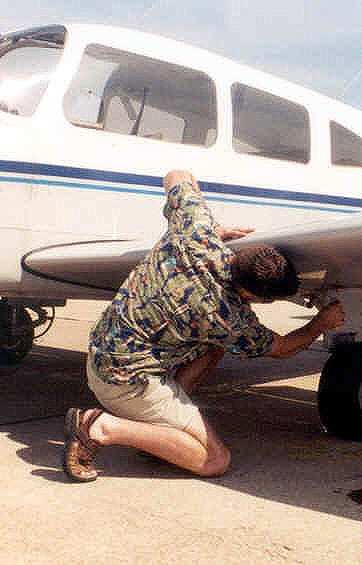Examiner Deals With Student Jitters
By Gary Wiblin, Editor, International Aviation Safety
Forum
I was booked to do an initial PPL test with a pleasant chap a
while back. I had often met him milling about our flying club and
judging by his obviously studious nature the test was to be a walk
in the park. After doing a good, thorough pre-flight inspection we
strapped ourselves into the aircraft for a perfect flight.
Everything was going along just great. The pre-start and
after-start checks were of a very high standard, brakes were
checked, taxi speed was kept in check, controls were held correctly
relative to wind, radio work was excellent, and the take-off and
after take-off checks were flawless. I was wishing that there were
more pilots of such a high calibre around.

We entered the general flying area at 4000' MSL and began
running through all the compulsory exercises required for the issue
of a PPL. The medium turn was great, the steep turn well within
limits. The applicant appeared calm, relaxed, and confident. What a
pleasure this was turning out to be. I then asked him to
demonstrate a stall. There was an immediate and abrupt change in
his composure. It was almost as if he had dreaded this moment all
along but had successfully managed to completely block it from his
conscious mind. In a now nervous and jittery state he ran through
the pre-stall checks.
I reminded him that he should just completely relax and perform
the maneuver exactly as he had been taught. He applied carb heat
and closed the throttle. He visibly tensed up as the stall warning
sounded and then harshly shoved the control column forward for the
recovery. This was followed immediately by his ramming the throttle
wide open and pulling back hard on the stick. Because the throttle
was opened so rapidly and possibly because the carb. heat was still
applied, the engine initially spluttered in protest before
bellowing indignantly to life. As we entered the secondary stall
and the left-hand wing dropped he fed in full right-hand aileron.
This had the effect of aggravating the stalled condition of the
left-hand wing and the aircraft wound up into a fast, flat
left-hand spin.
Judging by the pained expression on our potential PPL's face, he
was not having a good day. There was no doubt about it. This chap
was absolutely petrified of unusual attitudes and was also
convinced that stalling was a state of flight over which he had
absolutely no control.
I personally believe that the most dangerous place to be is in
an aircraft with a pilot who is in control only within certain
parameters. In the foregoing example the potential pilot not only
lost control of the aircraft but actually let go of the controls
and clung to the bottom of his seat.
 I wish it were within my powers to
prevent such people from ever attaining a PPL but unfortunately it
isn't. This particular person went to another flying school where
he was somehow able to sneak through the system. This frightens me
immensely. Our skies are cluttered with pilots who are actually
terrified of flying, yet continue to do so to satisfy some strange
logic.
I wish it were within my powers to
prevent such people from ever attaining a PPL but unfortunately it
isn't. This particular person went to another flying school where
he was somehow able to sneak through the system. This frightens me
immensely. Our skies are cluttered with pilots who are actually
terrified of flying, yet continue to do so to satisfy some strange
logic.
In some cases this may only be an initial fear of the unknown
and can often be cured with briefings and practising unusual
attitude recovery. Once a student fully understands that an
aircraft is fully controllable throughout all phases of flight
his/her initial fears can usually easily be allayed. I had a case
some years ago where a student fully acknowledged his fear of
unusual attitudes and had me run him through unusual attitude
recovery and mild aerobatics (in an aerobat) over and over ad
nauseum until he not only got used to it, but actually enjoyed
stalling and spinning.
My point is, if there is some part of your aviation training
that scares you, you are doing yourself a disservice by trying to
avoid the inevitable. Rather get your instructor to run you through
the exercise on the ground and in the air as many times as is
necessary.
 ANN's Daily Aero-Linx (04.16.24)
ANN's Daily Aero-Linx (04.16.24) Aero-News: Quote of the Day (04.16.24)
Aero-News: Quote of the Day (04.16.24) Airborne 04.10.24: SnF24!, A50 Heritage Reveal, HeliCycle!, Montaer MC-01
Airborne 04.10.24: SnF24!, A50 Heritage Reveal, HeliCycle!, Montaer MC-01 Airborne 04.12.24: SnF24!, G100UL Is Here, Holy Micro, Plane Tags
Airborne 04.12.24: SnF24!, G100UL Is Here, Holy Micro, Plane Tags Airborne-Flight Training 04.17.24: Feds Need Controllers, Spirit Delay, Redbird
Airborne-Flight Training 04.17.24: Feds Need Controllers, Spirit Delay, Redbird




